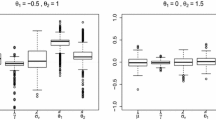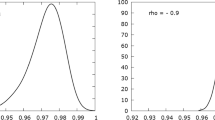Abstract
In this chapter we present several new findings on the NoVaS transformation approach for volatility forecasting introduced by Politis (Model-Free Volatility Prediction, UCSD Department of Economics Discussion Paper 2003–16; Recent advances and trends in nonparametric statistics, Elsevier, North Holland; J Financ Econ 5:358–389, 2007). In particular: (a) we present a new method for accurate volatility forecasting using NoVaS; (b) we introduce a “time-varying” version of NoVaS and show that the NoVaS methodology is applicable in situations where (global) stationarity for returns fails such as the cases of local stationarity and/or structural breaks and/or model uncertainty; (c) we conduct an extensive simulation study on the forecasting ability of the NoVaS approach under a variety of realistic data generating processes (DGP); and (d) we illustrate the forecasting ability of NoVaS on a number of real data sets and compare it to realized and range-based volatility measures. Our empirical results show that the NoVaS -based forecasts lead to a much ‘tighter’ distribution of the forecasting performance measure. Perhaps our most remarkable finding is the robustness of the NoVaS forecasts in the context of structural breaks and/or other nonstationarities of the underlying data. Also striking is that forecasts based on NoVaS invariably outperform those based on the benchmark GARCH(1,1) even when the true DGP is GARCH(1,1) when the sample size is moderately large, e.g., 350 daily observations.
Earlier results from this research were presented in seminars in the Departments of Economics of the University of California at San Diego, University of Cyprus, and the University of Crete, as well as several conferences. We would like to thank Elena Andreou, conference and seminar participants for useful comments and suggestions. Many thanks are also due to an anonymous referee for a most constructive report, and to the Editors, **aohong Chen and Norman Swanson, for all their hard work in putting this volume together.
Access this chapter
Tax calculation will be finalised at checkout
Purchases are for personal use only
Similar content being viewed by others
Notes
- 1.
See also Politis and Thomakos (2008).
- 2.
- 3.
See the discussion about the calibration of \(\alpha \) and \(\displaystyle \varvec{a}\) in the next section.
- 4.
- 5.
This might well be the case of the EFG data set of Sect. 4 in what follows.
- 6.
See also the recent chapter by Hansen and Lunde (2006) about the relevance of MSE in evaluating volatility forecasts.
- 7.
This part of the NoVaS application appears similar at the outset to the Minimum Distance Method (MDM) of Wolfowitz (1957). Nevertheless, their objectives are quite different since the latter is typically employed for parameter estimation and testing whereas in NoVaS there is little interest in parameters—the focus lying on effective forecasting.
- 8.
- 9.
In our design we do not just go for a limited number of DGPs but for a wide variety and we also generate a large number of observations, totalling over 4 million, across models and replications. Note that the main computational burden is the numerical (re)optimization of the GARCH model over 300 K times across all simulations—and that involves (re)optimization only every 20 observations!.
- 10.
We fix the degrees of freedom to their true value of 3 during estimation and forecasting, thus giving GARCH a relative advantage in estimation.
- 11.
The phenomenon of poor performance of GARCH forecasting when the DGP is actually GARCH may seem puzzling and certainly deserves further study. Our experience based on the simulations suggests that the culprit is the occasional instability of the numerical MLE used to fit the GARCH model (computations performed in R using an explicit log-likelihood function with R optimization routines). Although in most trials the GARCH fitted parameters were accurate, every so often the numerical MLE gave grossly inaccurate answers which, of course, affect the statistics of forecasting performance. This instability was less pronounced when the fitting was done based on a large sample (case of 900). Surprisingly, a training sample as large as 250 (e.g. a year of daily data) was not enough to ward off the negative effects of this instability in fitting (and forecasting) based on the GARCH model.
- 12.
All NoVaS forecasts were made without applying an explicit predictor as all \(W_{t}(\displaystyle \varvec{\theta }^{*})\) series were found to be uncorrelated.
- 13.
Note also the performance improvement from the use of the median GARCH versus the mean GARCH forecasts for the MSFT series. Recall that our simulation results showed that the performance of a GARCH model could be way off the mark if the training sample was small; here we use only 157 observations for training the MSFT series and the GARCH forecasts cannot outperform even the Naive benchmark.
- 14.
For the MSFT series the benchmark forecasts are also significantly better than the GARCH forecasts.
- 15.
Changing the value of \(\alpha \) did not result in improvements in the other three series.
References
Andersen, T.G., Bollerslev, T., Christoffersen, P.F., and F. X. Diebold, 2006. “Volatility and Correlation Forecasting” in G. Elliott, C.W.J. Granger, and Allan Timmermann (eds.), Handbook of Economic Forecasting, Amsterdam: North-Holland, pp. 778–878.
Andersen, T.G., Bollerslev, T. and Meddahi, N., 2004. “Analytic evaluation of volatility forecasts”, International Economic Review, vol. 45, pp. 1079–1110.
Andersen, T.G., Bollerslev, T. and Meddahi, N., 2005. “Correcting the Errors: Volatility Forecast Evaluation Using High-Frequency Data and Realized Volatilities”, Econometrica, vol. 73, pp. 279–296.
Bandi, F.M. and J.R. Russell, 2008. “Microstructure noise, realized variance, and optimal sampling”, Review of Economic Studies, vol. 75, pp. 339–369.
Berkes, I. and L. Horvath, 2004. “The efficiency of the estimators of the parameters in GARCH processes”, Annals of Statistics, 32, pp. 633–655.
Chen, K., Gerlach, R. and Lin, E.W.M., 2008. “Volatility forecasting using threshold heteroscedastic models of the intra-day range”, Computational Statistics & Data Analysis, vol. 52, pp. 2990–3010.
Choi, K., Yu, W.-C. and E. Zivot, 2010. “Long memory versus structural breaks in modeling and forecasting realized volatility”, Journal of International Money and Finance, vol. 29, pp. 857–875.
Dahlhaus, R. (1997), “Fitting time series models to nonstationary processes”, Annals of Statistics, 25 pp. 1–37.
Dahlhaus, R. and S. Subba-Rao, 2006. “Statistical Inference for Time-Varying ARCH Processes”, Annals of Statistics, vol. 34, pp. 1075–1114.
Dahlhaus, R. and S. Subba-Rao, 2007. “A Recursive Online Algorithm for the Estimation of Time Varying ARCH Parameters”, Bernoulli, vol 13, pp. 389–422.
Diebold, F. X. and R. S. Mariano, 1995. “Comparing Predictive Accuracy”, Journal of Business and Economic Statistics, vol. 13, pp. 253–263.
Francq, C. and J-M. Zakoian, 2005. “L2 Structures of Standard and Switching-Regime GARCH Models”, Stochastic Processes and Their Applications, 115, pp. 1557–1582.
Fryzlewicz, P., Sapatinas, T. and S. Subba-Rao, 2006. “A Haar-Fisz Technique for Locally Stationary Volatility Estimation”, Biometrika, vol. 93, pp. 687–704.
Fryzlewicz, P., Sapatinas, T. and S. Subba-Rao, 2008. “Normalized Least Squares Estimation in Time-Varying ARCH Models”, Annals of Statistics, vol. 36, pp. 742–786.
Ghysels, E. and L. Forsberg, 2007. “Why Do Absolute Returns Predict Volatility So Well?”, Journal of Financial Econometrics, vol. 5, pp. 31–67.
Ghysels, E. and B. Sohn, 2009. “Which power variation predicts volatility well?”, Journal of Empirical Finance, vol. 16, pp. 686–700.
Ghysels, E., P. Santa-Clara, and R. Valkanov, 2006. “Predicting Volatility: How to Get Most Out of Returns Data Sampled at Different Frequencies”, Journal of Econometrics, vol. 131, pp. 59–95.
Hall, P. and Q. Yao, 2003. “Inference in ARCH and GARCH Models with heavy-tailed errors”, Econometrica, 71, pp. 285–317.
Hansen, B., 2006. “Interval Forecasts and Parameter Uncertainty”, Journal of Econometrics, 127–377-398.
Hansen, P. R. and A. Lunde, 2005. “A forecast comparison of volatility models: does anything beat a \(GARCH(1,1)\)?”, Journal of Applied Econometrics, 20(7):873–889.
Hansen, P. R. and A. Lunde, 2006. “Consistent ranking of volatility models”, Journal of Econometrics, 131, pp. 97–121.
Hansen, P.R., Lunde, A. and Nason, J.M., 2003. “Choosing the best volatility models: the model confidence set approach”, Oxford Bulletin of Economics and Statistics, vol. 65, pp. 839–861.
Hillebrand, E. 2005. “Neglecting Parameter Changes in GARCH Models”, Journal of Econometrics, 129, pp. 121–138.
Lux, T. and L. Morales-Arias, 2010. “Forecasting volatility under fractality, regime switching, long-memory and t-innovations”, Computational Statistics & Data Analysis, vol. 54, pp. 2676–2692.
Meddahi, N., 2001. “An eigenfunction approach for volatility modeling”, Technical report, CIRANO Working paper 2001s–70, Univiversity of Montreal.
Mikosch, T. and C. Starica, 2004. “Change of Structure in Financial Time Series, Long Range Dependence and the GARCH model”, CAF Working Paper Series, No. 58.
Parkinson, M., 1980. “The Extreme Value Method for Estimating the Variance of the Rate of Return”, Journal of Business, 53, pp. 61–68.
Patton, A., 2011. “Volatility forecast evaluation and comparison using imperfect volatility proxies”, Journal of Econometrics, vol. 160, pp. 246–256.
Patton, A. and K. Sheppard, 2008. “Evaluating volatility and correlation forecasts”, in T. G. Andersen et al., (Eds.), Handbook of Financial Time Series, Springer Verlag.
Patton, A. and K. Sheppard, 2009. “Optimal combinations of realized volatility estimators”, International Journal of Forecasting, vol. 25, pp. 218–238.
Peng, L. and Q. Yao, 2003. “Least absolute deviations estimation for ARCH and GARCH models”, Biometrika, 90, pp. 967–975.
Politis, D.N., 2003a. “Model-Free Volatility Prediction”, UCSD Dept. of Economics Discussion Paper 2003–16.
Politis, D.N., 2003b. “A Normalizing and Variance-Stabilizing Transformation for Financial Time Series”, in Recent Advances and Trends in Nonparametric Statistics, M.G. Akritas and D.N. Politis, (Eds.), Elsevier: North Holland, pp. 335–347.
Politis, D.N., 2004. “A heavy-tailed distribution for ARCH residuals with application to volatility prediction”, Annals of Economics and Finance, vol. 5, pp. 283–298.
Politis, D.N., 2007. “Model-free vs. model-based volatility prediction”, J. Financial Econometrics, vol. 5, pp. 358–389.
Politis, D. and D. Thomakos, 2008. “Financial Time Series and Volatility Prediction using NoVaSTransformations", in Forecasting in the Presence of Parameter Uncertainty and Structural Breaks, D. E. Rapach and M. E. Wohar (Eds.), Emerald Group Publishing Ltd.
Poon, S. and C. Granger, 2003. “Forecasting Volatility in Financial Markets: A Review”. Journal of Economic Literature, 41, pp. 478–539.
Taylor, J., 2004. “Volatility Forecasting using Smooth Transition Exponential Smoothing”, International Journal of Forecasting, vol. 20, pp. 273–286.
Wolfowitz, A., 1957. “The Minimum Distance Method”, Annals of Mathematical Statistics, 28, pp. 75–88.
Author information
Authors and Affiliations
Corresponding author
Editor information
Editors and Affiliations
Rights and permissions
Copyright information
© 2013 Springer Science+Business Media New York
About this chapter
Cite this chapter
Politis, D.N., Thomakos, D.D. (2013). NoVaS Transformations: Flexible Inference for Volatility Forecasting. In: Chen, X., Swanson, N. (eds) Recent Advances and Future Directions in Causality, Prediction, and Specification Analysis. Springer, New York, NY. https://doi.org/10.1007/978-1-4614-1653-1_19
Download citation
DOI: https://doi.org/10.1007/978-1-4614-1653-1_19
Published:
Publisher Name: Springer, New York, NY
Print ISBN: 978-1-4614-1652-4
Online ISBN: 978-1-4614-1653-1
eBook Packages: Business and EconomicsEconomics and Finance (R0)




